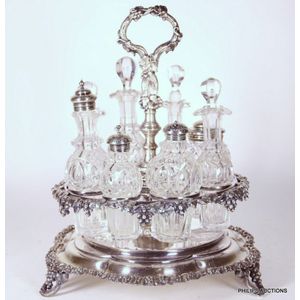Gilded Rococo Console Table with Mirror
You must be a subscriber, and be logged in to view price and dealer details.
Subscribe Now to view actual auction price for this item
When you subscribe, you have the option of setting the currency in which to display prices to $Au, $US, $NZ or Stg.
- Rococo - A stylistic development covering the period from about 1730 to 1770, during the reign of Louis XV in France. The rococo style falls between the rather overbearing manner of the Baroque and the formal elegance of Neoclassicism. The Rococo style reached its full maturity in France, though many of its features were used by English furniture makers. The style is marked by asymmetrical forms, especially pierced and intricate scroll work as in mirror frames, chair backs etc., and the use of shells and floral motifs. The term derives from the French 'rocaille', meaning rock work, as in gardens and fountains. There was a major Rococo revival in the mid-19th century and indeed much of what is now considered to be typically Victorian furniture is influenced by the Rococo. It is essentially feminine in feeling, and for this reason, perhaps, was regarded as rather frivolous by its successors.
- Pierced Decoration - Ornamental woodwork with part of the background cut through and removed to produce an open-work pattern.
- Gilding - Gilding is a method of ornamentation whereby a thin sheet of gold metal is applied to items made of wood, leather, ceramics, glass and silver for decorative purposes.
For furniture including mirrors, the sheet of gold is usually applied over a coating of gesso. Gesso is a mixture of plaster of Paris and gypsum mixed with water and then applied to the carved wooden frames of mirrors and picture frames as a base for applying the gold leaf. After numerous coats of gesso have been applied, allowed to dry and then sanded a coat of "bole", a usually red coloured mixture of clay and glue is brushed on and allowed to dry, after which the gold leaf is applied. Over time parts of the gilding will rub off so the base colour can be seen. In water gilding, this was generally a blue colour, while in oil gilding, the under layer was often yellow. In Victorian times, gilders frequently used red as a pigment beneath the gold leaf.
Metal was often gilded by a process known as fire gilding. Gold mixed with mercury was applied and heated, causing the mercury to evaporate, the long-term effect of which was to kill or disable the craftsman or woman from mercury poisoning. The pursuit of beauty has claimed many victims, not the least of which were the artists who made those pieces so highly sought after today.
This item has been included into following indexes:
Visually similar items

Ornate gilt gesso mirror, with open scroll work borders and original mirror

Box of vintage costume jewellery

A pair of French style gilt wall mirrors approximately 200 x 110 cm

A fine Victorian silver plate revolving Eight-Bottle cruet, 1859, maker's mark of Elkington & Co, the circular body raised on three vine leaf feet with an applied vine rim, frame and loop handle, supporting matching cut glass bottles for salt and pepper, s
